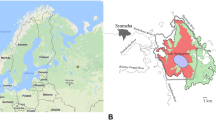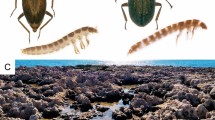Abstract
Ombrotrophic peat bogs from Tierra del Fuego are characteristically raised, dome-shaped, fed by precipitation, and nutrient-poor. Their landscape pattern consists of a Sphagnum magellanicum matrix encompassing pools with different morphometric and trophic features. Within the framework of a 2-year limnological survey in five pools from Rancho Hambre peat bog, we analyzed phytoplankton communities under the hypothesis that taxonomic composition would show a spatial pattern driven by ultimately landscape-controlled environmental features such as pH and trophic status, while temperature and weather-dependent features would account for seasonal changes in abundance and structure. Among the 305 taxa recorded, most were Conjugatophyceae and Bacillariophyceae, and were strongly associated to circumneutral pH and minerotrophic conditions, though limited superficial connectivity among pools accounted for dissimilar taxonomic compositions. Despite such differences, phytoplankton of pools with similar morphometry and trophic status showed similar dominant and richest taxonomic groups undergoing paralell changes over time. Seasonal temperature fluctuations were modulated by pool size and modified not only abiotic properties but also phytoplankton abundance, with different taxa showing strong summer peaks in different pools. An interpretative model is proposed which will be tested as a tool for predicting community strategy and temporal variation patterns as responses to different environmental templates.






Similar content being viewed by others
References
Battarbee, E. W., 1986. Diatom analysis. In Berglund, B. E. (ed.), Handbook of Holocene Palaeoecology and Palaeohydrology. Wiley, New York: 527–570.
Borics, G., B. Tothmérész, I. Grigorszky, J. Padisák, G. Várbíro & S. Szabó, 2003. Algal assemblage types of bog-lakes in Hungary and their relation to water chemistry, hydrological conditions and habitat diversity. Hydrobiologia 502: 145–155.
Callieri, C. & M. L. Pinolini, 1995. Picoplankton in Lake Maggiore, Italy. International Revue der gesamten Hydrobiologie 80: 491–501.
Černá, K., 2010. Small-scale spatial variation of benthic algal assemblages in a peat bog. Limnologica, Ecology and Management of Inland Waters 40: 315–321.
Clymo, R. S., 1964. The origin of acidity in Sphagnum bogs. The Bryologist 67: 427–431.
Coronato, A., C. Roig, L. Collado & F. Roig, 2006. Geomorphologic emplacement and vegetation characteristics of Fuegian peatlands, southernmost Argentina, South America. In Martini, A. (ed.), Peatlands Evolution and Records of Environmental and Climate Changes. Elsevier, Amsterdam: 111–128.
Cosandey, F., 1964. La tourbière des Tenasses sur Vevey. Matériaux pour la léve géobotanique de la Suisse 45: 1–324.
Druvietis, I., G. Spriņǵe, A. Briede, I. Kokorīte & E. Parele, 2010. A comparative assessment of the bog aquatic environment of the Ramsar Site of Teiči Nature Reserve and North Vidzeme Biosphere Reserve, Latvia. In Kļaviņš, M. (ed.), Mires and peat. University of Latvia Press, Riga: 19–40.
González Garraza, G., 2012. Fracciones de tamaño del fitoplancton de las lagunas de la turbera de Rancho Hambre (Tierra del Fuego): caracterización y relación con los factores bióticos y abióticos. PhD Thesis. Universidad de Buenos Aires.
González Garraza, G., G. Mataloni, R. Iturraspe, R. Lombardo, S. Camargo & M. V. Quiroga, 2012. The limnological character of bog pools in relation to meteorological and hydrological features. Mires and Peat 10: 1–14.
Grootjans, A., R. Iturraspe, A. Lanting, C. Fritz & H. Joosten, 2010. Ecohydrological features of some contrasting mires in Tierra del Fuego, Argentina. Mires and Peat 6: 1–15.
Iréneée-Marie, F. I. C., 1939. Flore Desmidiale de la Region de Montreal. Laprairie, Canada.
Iturraspe, R., 2010. Las turberas de Tierra del Fuego y el cambio climático global. Fundación Humedales/Wetlands International, Buenos Aires.
Izaguirre, I., A. Vinocur, G. Mataloni & M. Pose, 1998. Phytoplankton communities in relation to trophic status in lakes from Hope Bay (Antarctic Peninsula). Hydrobiologia 369(370): 73–87.
Joosten, H. & D. Clarke, 2002. Wise Use of Mires and Peatlands. Background and Principles Including a Framework for Decision-Making. International Mire Conservation Group/International Peat Society, Finlandia.
Jürgens, K. & C. Matz, 2002. Predation as a shaping force for the phenotypic and genotypic composition of planktonic bacteria. Antonie van Leeuwenhoek 81: 413–434.
Komárek, J. & K. Anagnostidis, 1999. Cyanoprokaryota. 1. Chroococcales. In Ettl, H., G. Gärtner, H. Heynig & D. Mollenhauer (eds), Süsswasserflora von Mitteleuropa 19/1. Jena, Stuttgart: 1–548.
Komárek, J. & K. Anagnostidis, 2005. Cyanoprokaryota. 2. Oscillatoriales. In Büdel, B., L. Krienitz, G. Gärtner & M. Schagerl (eds), Süsswasserflora von Mitteleuropa 19/2. München, Heidelberg: 1–759.
Komárek, J. & B. Fott, 1983. Chlorophyceae, Chlorococcales. In: Elster, H.J. & W. Ohle (eds), Die Binnengewässer. Das Phytoplankton des Süsswassers 16/7. Nägele and Obermiller, Stuttgart: 1–1044.
Krammer, K. & H. Lange-Bertalot, 1986. Bacillariophyceae. 1. Naviculaceae. In Ettl, H., J. Gerloff, H. Heying, H. & D. Mollenhauer (eds), Süsswasserflora von Mitteleuropa. 2/1. Fischer-Verlag, Jena: 1–876.
Krammer, K. & H. Lange-Bertalot, 1988. Bacillariophyceae. 2. Bacillariaceae, Epithemiaceae, Surirellaceae. In Ettl, H., J. Gerloff, H. Heying, H. & D. Mollenhauer (eds), Süsswasserflora von Mitteleuropa. 2/2. Fischer-Verlag, Jena: 1–596.
Krammer, K. & H. Lange-Bertalot, 1991a. Bacillariophyceae. 3. Centrales, Fragilariaceae, Eunotiaceae. In Ettl, H., J. Gerloff, H. Heying, H. & D. Mollenhauer (eds), Süsswasserflora von Mitteleuropa. 2/3. Fischer-Verlag, Jena: 1–576.
Krammer, K. & H. Lange-Bertalot, 1991b. Bacillariophyceae. 4. Achnanthaceae, kritische ergänzungen zu Navicula (Lineolatae) und Gomphonema, Gesamtliteraturverzeichnis Teil 1–4. In Ettl, H., G. Gärtner, J. Gerloff, H. Heying, H. & D. Mollenhauer (eds), Süsswasserflora von Mitteleuropa. 2/4. Fischer-Verlag, Stuttgart, Jena: 1–437.
Krivograd Klemenčič, A., N. Smolar-Žvanut, D. Istenič & T. Griessler-Bulc, 2010. Algal community patterns in Slovenian bogs along environmental gradients. Biology 65: 422–437.
Lara, E., D. Singer, C. Seppey, G. González Garraza, M. V. Quiroga & G. Mataloni, 2014. Biodiversidad del plancton eucariota <3 µm en una turbera fueguina revelada por secuenciación masiva. In VI Congreso Argentino de Limnología. La Plata, 14–18, Sept 2014.
Lindsay, R. A., D. J. Charman, F. Everingham, R. M. O’Reilly, M. A. Palmer, T. A. Rowell & D. A. Stroud, 1988. The Flow Country. The Peatlands of Caithness and Sutherland. Nature Conservancy Council, Peterborough.
Magurran, A. E., 2004. Measuring Biological Diversity. Blackwell Science Publishing, Oxford.
Marker, A. F. H., E. A. Nusch, H. Rai & B. Riemann, 1980. The measurement of photosynthetic pigments in freshwaters and standardization of methods: conclusions and recommendations. Archive für Hydrobiologie Beih. Ergebnisse der Limnologie 14: 91–106.
Mataloni, G., 1991. Remarks on the distribution and ecology of some desmids from Tierra del Fuego (Argentina). Nova Hedwigia 53: 433–443.
Mataloni, G., 1995a. Cyanodictyon reticulatum (Lemm.) Geitler and Alternantia geitleri Schiller (Chlorococcales). Two rare species from Tierra del Fuego (Argentina) peat bogs. Cryptogamic Botany 5: 1–4.
Mataloni, G., 1995b. Ecological notes on some interesting desmids from Tierra del Fuego (Argentina) peat bogs. Nova Hedwigia 60: 135–144.
Mataloni, G., 1997. Flora algal de las turberas de Tierra del Fuego. Contribución del Instituto Antártico Argentino. No. 467. Instituto Antártico Argentino, Buenos Aires.
Mataloni, G. & G. Tell, 1996. Comparative analysis of the phytoplankton communities of a peat bog from Tierra del Fuego (Argentina). Hydrobiologia 325: 101–112.
Mataloni, G., G. Tesolin, F. Sacullo & G. Tell, 2000. Factors regulating summer phytoplankton in a highly eutrophic Antarctic lake. Hydrobiologia 432: 65–72.
Neustupa, J., K. Černá & J. Št’astný, 2009. Diversity and morphological disparity of desmid assemblages in Central European peatlands. Hydrobiologia 630: 243–256.
Nováková, S., 2002. Algal flora of subalpine peat bog pools in the Krkonoše Mts. Preslia, Praha 74: 45–56.
Parish, F., A. Sirin, D. Charman, H. Joosten, T. Minaeva & M. Silvius, 2008. Assessment on Peatlands, Biodiversity and Climate Change. Global Environment Centre and Wetlands International, Kuala Lumpur and Wageningen.
Porter, K. G. & Y. S. Feig, 1980. The use of DAPI for identifying and counting aquatic microflora. Limnology and Oceanography 25: 943–948.
Quiroga, M. V., F. Unrein, G. González Garraza, G. Küppers, R. Lombardo, M. C. Marinone, S. Menú Marque, A. Vinocur & G. Mataloni, 2013. The plankton communities from peat bog pools: structure, temporal variation and environmental factors. Journal of Plankton Research 35: 1234–1253.
Rauch, A., C. Fesl & M. Schagerl, 2006. Influence of environmental variables on algal associations from a floating vegetation mat (Schwingmoor Lake Lunzer Obersee, Austria). Aquatic Botany 84: 129–136.
Roig, C. & F. A. Roig, 2004. Consideraciones generales. In Blanco, D. E. & V. M. de la Balze (eds), Los Turbales de la Patagonia, bases para su inventario y la conservación de su biodiversidad. Fundación Humedales. Wetlands International, Buenos Aires: 5–21.
Štěpánková, J., J. Vavruskova, P. Hasler, P. Mazalová & A. Poulícková, 2008. Diversity and ecology of desmids of peat bogs in the Jizerské hory Mst. Biologia 63: 891–896.
ter Braak, C. J. F. & P. Šmilauer, 1998. CANOCO Reference Manual and Canoco Draw for Windows User´s Guide: software for canonical community ordination (version 4.5). Microcomputer Power, Ithaca.
Utermöhl, M., 1958. Zur Vervollkomnung der quantitativen Phytoplankton-Methodik. (For the perfection of quantitative phytoplankton methodology). Mitteilungen. Communications. Internationale Vereiningung für Theoretische und Angewandte Limnologie 9: 1–38.
Venrick, E. L., 1978. How many cells to count? In Sournia, A. (ed.), Phytoplankton Manual. UNESCO, Paris: 167–180.
Vincent, W. F., J. E. Hobbie & J. Laybourn-Parry, 2008. Introduction to the limnology of high latitude lake and river ecosystems. In Vincent, W. F., J. E. Hobbie & J. Laybourn-Parry (eds), Polar Lakes and Rivers Limnology of Arctic and Antarctic Aquatic Ecosystems. Oxford University Press, Oxford: 1–24.
West, W. & G. S. West, 1904. A Monograph of the British Desmidiaceae. I. Ray Society, London.
West, W. & G. S. West, 1905. A Monograph of the British Desmidiaceae. II. Ray Society, London.
West, W. & G. S. West, 1908. A Monograph of the British Desmidiaceae. III. Ray Society, London.
West, W. & G. S. West, 1912. A Monograph of the British Desmidiaceae. IV. Ray Society, London.
West, W. & G. S. West, 1922. A Monograph of the British Desmidiaceae, Vol. V. Ray Society, London.
Zar, J. H., 2010. Biostatistical Analysis. Pearson Prentice Hall, Upper Saddle River.
Acknowledgments
We are grateful to the Secretaría de Desarrollo Sustentable y Ambiente, Dirección General de Recursos Hídricos, Provincia de Tierra del Fuego and the Centro Austral de Investigaciones Científicas (CADIC)-CONICET for much valued logistical support. A major limnological project involving this research was financed by the Agencia Nacional de Investigaciones Científicas y Tecnológicas (ANPCyT) through research Grant PICT 2006–1697. Thanks are due to all researchers who took part in sampling campaigns: Rodolfo Iturraspe, Sergio Camargo, Cristina Marinone, Silvina Menu Marque, Gabriela Küppers, M. Victoria Quiroga, Rubén Lombardo, Fernando Unrein, Carlos Vélez, Guillermo Tell and Adrián Rua. Comments on the original MS by Dr. M. Victoria Quiroga and two anonymous referees were much appreciated.
Author information
Authors and Affiliations
Corresponding author
Additional information
Handling editor: Judit Padisak
Rights and permissions
About this article
Cite this article
Mataloni, G., González Garraza, G. & Vinocur, A. Landscape-driven environmental variability largely determines abiotic characteristics and phytoplankton patterns in peat bog pools (Tierra del Fuego, Argentina). Hydrobiologia 751, 105–125 (2015). https://doi.org/10.1007/s10750-015-2175-7
Received:
Revised:
Accepted:
Published:
Issue Date:
DOI: https://doi.org/10.1007/s10750-015-2175-7




